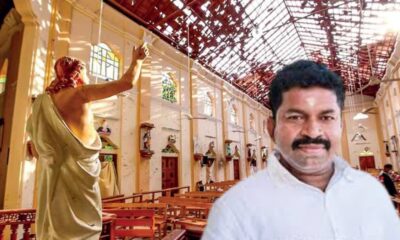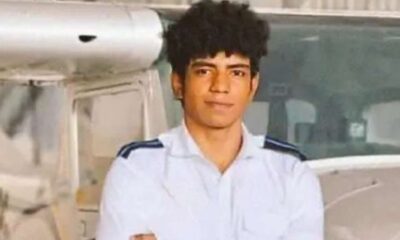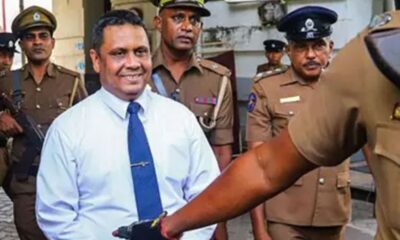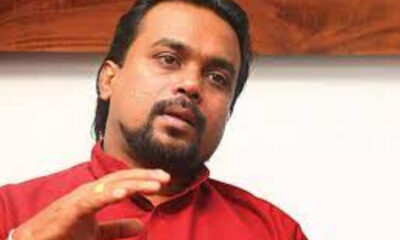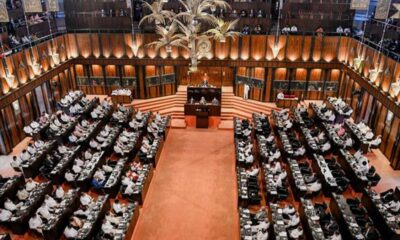FEATURES
Coming out of the crisis – Geopolitics and IMF – Part I
Published
3 years agoon
By
editor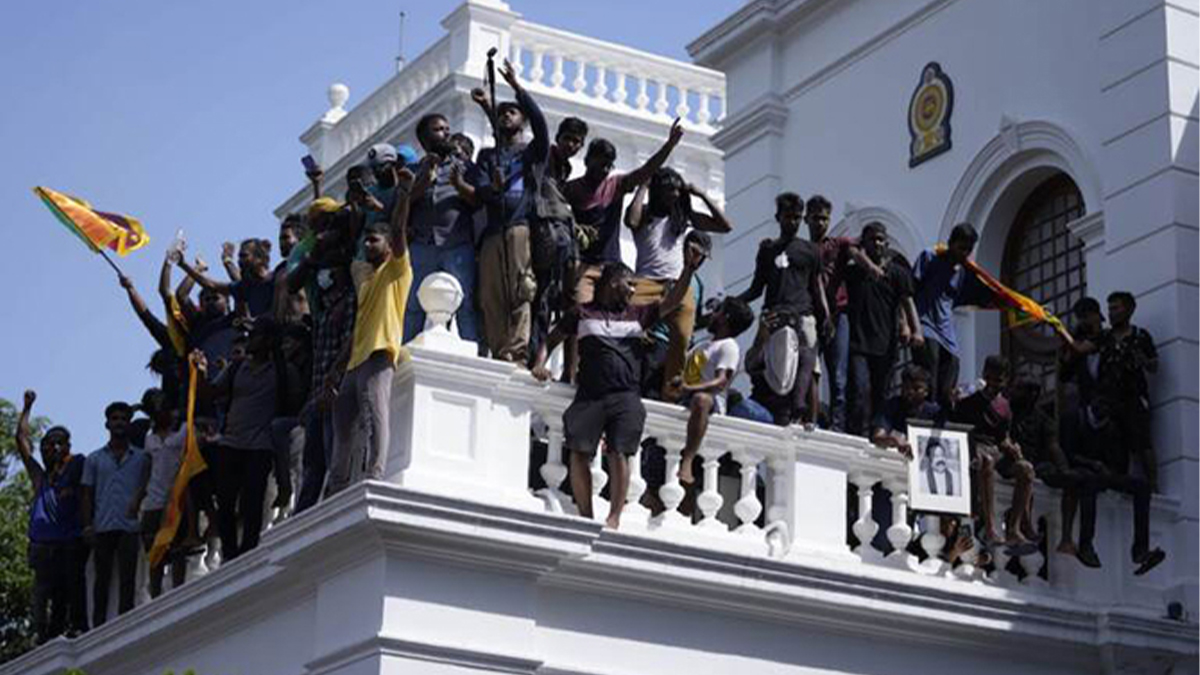
Politics of #GotaGoHome protests and arrival of IMF
Present economic chaos is neither “pandemic” made nor “Gota” made crisis per se. It was in the making with the free market economy for decades, was accelerated on top gear during the second presidential tenure of Mahinda Rajapaksa and continued with less noise through “yahapalanaya” of PM Wickramasinghe. The heavily corrupt and looted economy by then got stuck with the Covid-19 pandemic and was shattered into smithereens under President Gotabhaya Rajapaksa, handled by a set of loony amateurs.
Initial collapse of the economy was spoken of in the agricultural sector with the total ban on chemical fertiliser and agri-inputs in end April 2021. By December 2021 there was growing resentment in the urban middleclass over quality of LP gas and its shortage with power cuts and fuel shortages bringing the forex crisis into the open in early January 2022. Towards mid-February, with urban middleclass life going haywire, Gota government was challenged by them at popular city locations. That led to the new middleclass protest culture at Galle face as the #GotaGoHome youth protest in first week of April with heavy campaigning on social media.
Youth groups that originally flagged the #GotaGoHome protest have now basically settled with unforeseen, unexpected double entry of Wickramasinghe as Executive President, heading a seemingly non-Rajapaksa government. #GotaGoHome campaigners have also gone silent on their initial public calls to reject the 225 Member parliament as corrupt. Recent appointments of 37 State Ministers have also left out 03 of the 04 Rajapaksas in parliament. With a few days pause on “power cuts” followed by a 01 hour plus tolerable cut with fuel queues out of sight, the urban middleclass has gradually gone back to their usual lifestyle, though with some uncertainty.
Political groups in the fringe who picked up on the protests from Galle face green took them out onto the streets as violent street fights inviting heavy repression from Wickramasinghe rule. Their call against arrests of “peaceful protesters” are being isolated from society, with the urban middleclass focussed more on “social stability necessary” and the would-be outcome of the “IMF bailout”. The repression meanwhile continues using the dreadful Prevention of Terrorism Act (PTA) with President Wickramasinghe least concerned about UNHRC Sessions, their Reports and Resolutions over 12 years old and with nothing conclusive. They don’t play adversely anymore on Wickramasinghe in Sri Lankan politics.
Geo-politics of “regime change”
Wickramasinghe first brought in as PM on 12 May with the ouster of PM Rajapaksa, immediately lifted the submerged economic crisis out from its political pit, in very concrete terms. He was obviously expected to lift the economic crisis into the major platform of social concern to revive the shattered open market economy. With a very bleak picture painted on the immediate future of the country he assured, “our friendly nations will come to assist us, but that would take a few months”. The implied message was his presence is what brings in aid from “friendly nations” and he is indispensable.
This novel “regime change” now firmly established with Wickramasinghe as Executive President. leaves covert geo-political manoeuvrings more conspicuous for political beavers to tunnel through. It’s seriously unthinkable how Sinhala-Buddhist South with its very backward culture, would have coined a slogan in English as #GotaGoHome. History of protests in Sinhala South have never known any slogan or demand coined in English. The slogan “Go Home” is quite common in English-speaking Western bloc, that Wickramasinghe calls “our friendly nations”. Obviously, it was planted in social media through few FB savvy youth. The campaign was being planned elsewhere with youth given a new “peaceful” flavour in protests calling for a “regime change” they did not know. They were not even aware despite their #GotaGoHome campaign, President Gotabhaya Rajapaksa was not the real target. The regime change planned was a “personality change” with PM Mahinda Rajapaksa sent home to install Wickramasinghe as PM.
Wickramasinghe’s ascend was seen by the urban middleclass as positive. Their distancing from Galle face thereafter led to leadership conflicts with numerous youth groups claiming sole ownership for the franchise of #GotaGoHome campaign and protest that was fast declining.
When parliament met on 17 May after a long adjournment the TNA Jaffna District MP Sumanthiran presenting his No Confidence Motion (NCM) against President Gotabhaya Rajapaksa in parliament, divulged a totally unknown connection between Wickramasinghe and the #GotaGoHome protest. He said Wickramasinghe vetted the NCM draft on 26 April and sent it to Galle face campaign organisers to obtain their approval before giving his consent to support the NCM. Sumanthiran for sure would not have let that cat out of the bag, had Wickramasinghe stayed with his previous promise to support the NCM in parliament.
That revealed links between Galle face protest, a politically scheming Wickramasinghe and the regime change the US had always wanted with them counting shots in a free market economy. US Ambassadress in Colombo Ms. Julie Chung was seen hurrying to protest against oppressive security intervention at Galle face on 09 May afternoon but had no interest in condemning attacks on public and private property and private residences of government politicians the following day. It took Ambassadress Chung hardly one hour to wish PM Wickramasinghe in a tweet after he was sworn in as PM promising the US would support Sri Lanka with IMF negotiations. PM Wickramasinghe’s decision to work along with IMF, was decided in Washington DC, before Colombo.
Next morning, first to meet PM Wickramasinghe were the Indian High Commissioner and the Ambassador for Japan in Colombo, two of the 04 “Quadrilateral Security Dialogue” (QSD) partners, others being the US and the Aussies. The US and India have always been overly concerned about China in Bay of Bengal and in Indo Pacific region that leave Sri Lanka as everyone’s pet pawn.
Then came the historic event of US Ambassadress Chung meeting with JVP leaders Anura Kumara and Vijitha Herath on 14 May at their party headquarters. While the JVP still pretends indifferent to that crucially timed surprising meet, Ambassadress Chung tweeted the same evening, “I continue to meet with a wide range of political representatives to encourage the Sri Lankan government’s efforts to move toward sustainable, inclusive solutions to the economic crisis,”. She had begun her campaign with no loss of time to ensure Wickramasinghe will not be adversely pressured by Opposition political parties.
Meanwhile new protests began with the Sinhala generic “aragalaya” by the Frontline Socialist Party (FSP) with ferocious outbursts using their politically monopolised Inter University Student Federation (IUSF), their party cadres and affiliates in semi-rural society brought to the streets against President Gotabhaya. This compelled the JVP to keep abreast of the vociferous FSP protests to satisfy their now mellowed party fans. Thus, forcing President Gotabhaya Rajapaksa to vacate his official residence and subsequently the presidency. That in turn gave Wickramasinghe the executive presidential power he was always denied through elections.
US has always been an important political ally for all who wanted the Rajapaksa regime ousted. One should also keep in mind it was the US and its Western lobby that created and funded the anti-Rajapaksa campaign on HR violations with elite Colombo based non-governmental organisations till 2015 January ouster of Rajapaksa government. These HR campaigners were shuttling between Geneva and Colombo twice every year till 2015, though not seen or heard now
Can Wickramasinghe sustain himself?
There is in Colombo middleclass society, more within the traditional and especially the globally exposed bi-lingual urbans, a subconscious feeling Wickramasinghe would be the leader who could muster international support to get Sri Lanka on its feet once again. For most Sri Lankans “International Community” is nothing but the Western power bloc. Within the traditional business community too there are corporate heads who prefer Wickramasinghe to most others. Their need to have a Western looking liberal leader, make them ignore the fact he miserably failed twice before. His reputation as an efficient and an effective political manager was proved a “tailored image” with faulty measurements that went beyond his capabilities. During his second tenure from 2015 January, he also failed to prove he is “Mr. Clean” as projected in urban middleclass circles.
Brought to replace the two top Rajapaksas in power and to work in tandem with the IMF, he is deep in a political crisis, while being tasked with the major responsibility of getting the dismantled economy put together. Interlocked, the two crises also provide him space though uncomfortable, for a political move or two. He has to ensure the SLPP parliamentary group stays with him, loyal or not. He also has to show the world he is in control of State agencies, including police and the defence forces. And then develop trust in urban society and in the private business community, he can negotiate an IMF bailout to revive the local economy. In short, he has to show the local and the international community, he is “not Gotabhaya”.
His initial effort was to keep the SLPP group pacified with a “Rajapaksa loyalist” (a Royalist too) appointed as Prime Minister with a small group of 18 more as cabinet ministers, to also impress People he is not wasting public funds on a jumbo cabinet. His attempt to please the People had to be abandoned to please SLPP and SLFP MPs in government. He has to make sure of a stable majority in parliament to push through bills and enactments as required by IMF conditions. He was thus compelled to compromise with the SLPP majority and some in the SLFP to provide 37 more positions as State Ministers.
Rest is now history with numerous interpretations about the #GotaGoHome Galle face protest, Wickramasinghe’s entry and the “aragalaya” thereafter. Now its IMF and Wickramasinghe who are in control of reviving the SL economy on their own terms. But what of the IMF bailout package itself with conditions not clearly spelt out? Will they lead to a new round of social protests outside everything that was mapped for Galle face? With just 01 vote in parliament and compelled to depend on SLPP vote bloc can Wickramasinghe hang on to the next 02 remaining years in power? IMF bailout package in a way would be the deciding factor of his stay.
– Kusal Perera
21 September 2022
(kusalperera.blogspot.com)
Part II is to follow…
You may like
FEATURES
Will JVP/NPP leaders respond to this, while dabbling on populist politics?
Published
2 days agoon
July 7, 2025By
editor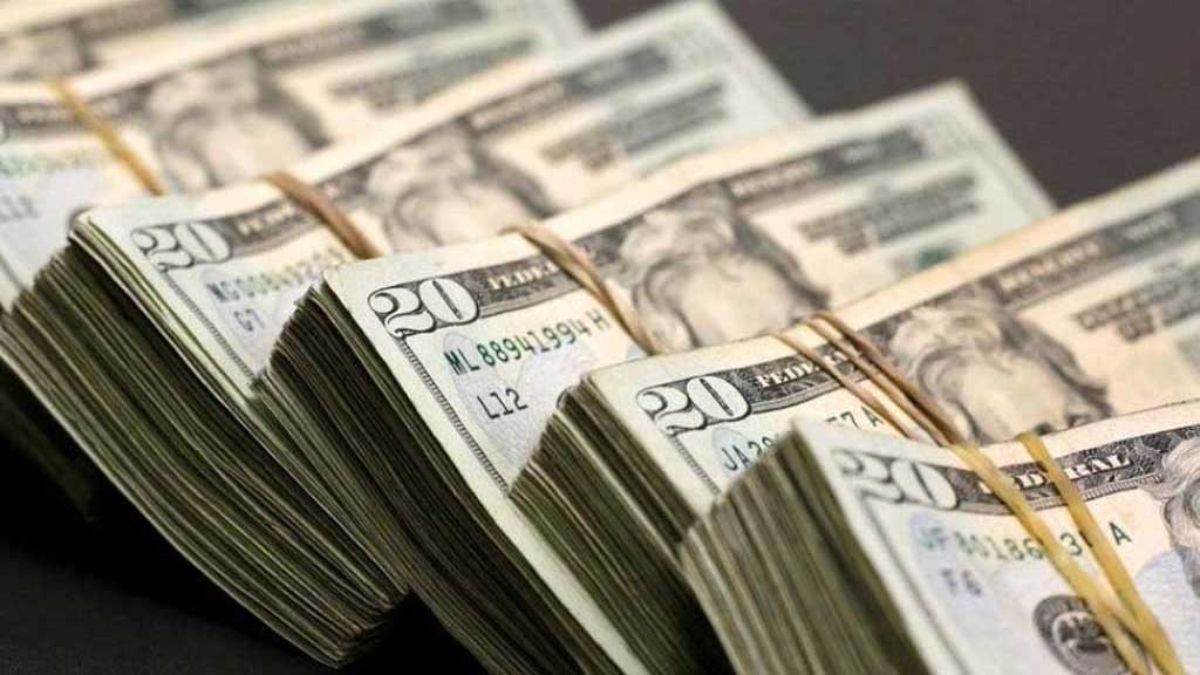
Half this year 2025 has also been spent with no answer to how Sri Lanka would begin settling its restructured foreign debts and interests on them, from year 2028 August. When President Wickramasinghe led government began discussing its foreign debt restructuring with the IMF framed within IMF conditions, Sri Lanka had amassed a massive USD 56,092.95 million by end third quarter 2024, the time we were tied to presidential election campaigns.
The last quarter with parliament elections also slotted in, the new President Anura Kumara Dissanayake (AKD), sworn in late September last year, had no time to intervene in the economy. Thus the fourth quarter of the year 2024, the first 03 months of President AKD’s rule closed in December with foreign debt increasing to USD 57,133.49 million. An increase of USD 1,040.54 million in 03 months. Sri Lanka had by then agreed with IMF to restructure USD 12.55 billion of its total debts.
According to the IMF agreement signed by President AKD’s NPP government, Sri Lanka has to begin repayments from 2028 August. That would be under AKD’s NPP rule.
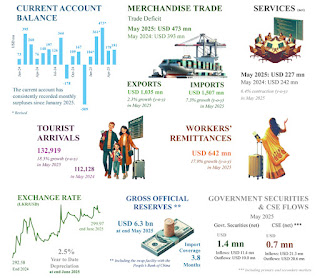
Meanwhile Sri Lanka has to settle this year 2025, a total of USD 2,454 million in routine debts including USD 1,085 million as interest, according to Deputy Minister of Economic Development, Anil Jayantha. That, excluding the annual foreign trade deficit the GoSL has to settle every year.
In year ending December 2024, the total foreign trade deficit was USD 6,100 million with an import bill of USD 18,841 million, an increase of 12.1 percent over the previous year, despite fuel imports decreasing. This year 2025, the trade deficit in month of May was USD 473 million, according to the CBSL figures published. This was an increase of 16.9 percent over previous year trade deficit in month of May.
We are in the midst of a two year Middle East armed conflict, that may drag on, even if it does not lead to a cease fire between Israel, Iran and the Hamas armed organisation in Palestine. Uncertainties looming in Middle East may not provide the dollar remittances from migrant labour the government estimated for this whole year and received during the past 05 months. Thus, GoSL may have to face a serious increase in the external trade deficit, if a miracle does not make a change. Assumed the increase would be around 10 percent over the previous year 2024, the external trade deficit may reach or even go beyond USD 6,710 million. To this, has to be added the annual routine debt of USD 2,454 million disclosed by Deputy Minister Jayantha in parliament, to have the total commitment of the GoSL for year 2025. That then would be USD 9,164 million in 2025.
As much as the NPP government, the SJB in Opposition is inefficient and intellectually timid too in responding to governance issues. Thus there is no serious, intellectual debate in how the government could earn the extra USD 9,164 million needed to bridge the trade deficit this 2025. The IMF has no proposal for increased exports to fetch extra dollars. They are only focussed on axing State expenses and increasing “Rupee income” with increased taxing. The IMF thus approved import of luxury vehicles as a source of Rupee income from taxes, wholly ignoring the fact, GoSL would have to burn a heavy load of hard earned dollars including remittances from migrant labour. From January this year till beginning of month of May, Sri Lanka had spent USD 200 million for vehicle imports, according to CBSL Governor Dr. Nandalal Weerasinghe. He told media on 22 May, the total value of Letters of Credit opened by then for vehicle imports was USD 450 million. And the NPP government seems happy with a tax collection of Rs.136 billion by end of April.
Now, what is important? Collecting 136 billion rupees, form spending USD 200 million for vehicles, that would need extra dollars for extra consumption of fuel, with greater traffic congestions on urban roads? Fact remains, the IMF has no programme, no proposal to increase the export and service income despite all tax concessions, privileges and State patronage for FDIs and for tourism development given by the State at the expense of the tax payer. The annual gap between import trade cost and the export trade income remains around USD 7,000 to 8,000 million with another USD 2,000 million required for debt servicing.
This should be stressed without ambiguity. The required extra annual income in many millions of dollars cannot be earned with Ministers reducing numbers in their vehicle fleet, from not taking residency in official bungalows, from reducing State expenses in patches, from Ministers stepping into paddy fields carrying a mammoty, or by indicting few officials and politicians of the previous regime.
We need a well designed national development plan that can guarantee annual increase in dollar exports to bridge a trade deficit of about USD 10,000 million. Will the JVP/NPP leadership tell the People what their plan is for such income earning, while going round with their populist propaganda stuff?
– Kusal Perera
FEATURES
Asweddumized fields and sizzling kottu roti: New words from Sri Lanka
Published
2 weeks agoon
June 26, 2025By
editor
In a letter dated 7 October 1971 and sent from Panadura, Ceylon, OED contributor Pearl Cooray wrote to then Chief Editor Robert Burchfield: ‘I have looked up references for the word asweddumize and have succeeded to a certain extent. The Sinhala word aswedduma means “land recently converted into a paddy field”, and the Anglicized word asweddumize means to prepare a field for sowing paddy’. Cooray was a Sri Lankan academic who visited Burchfield in Oxford earlier in 1971, and upon returning to her country and her position in the Dictionary Department of the University of Ceylon, briefly corresponded with the OED, sending the above quoted letter as well as a selection of Sri Lankan newspapers and magazines for the reading programme for the OED Supplements that were in preparation at the time. Her suggestion for asweddumize would have been too late for the word to be considered for Volume I of the Supplements, so Burchfield wrote the word and definition on a paper slip, the main means by which words were tracked until the 2010s, and filed it alongside an earlier slip from July 1970 with the same suggestion from another Sri Lankan contributor, D. N. Ponnamperuma.
Nothing further is found about asweddumize in the OED’s files until 1986, when botanist D. J. Mabberley, a regular consultant for the Supplement, sent in a quotation slip for the word, which he would have encountered during the time he spent at a university in Sri Lanka. A decade later, another slip records the decision made not to draft an entry for asweddumize due to lack of evidence. ‘Omit (sadly)’was the responsible editor’s regretful note on the slip.
Almost thirty years later, this sad omission has finally been rectified, with the addition of asweddumize to the OED as part of this update. Current OED Sri Lankan English consultant Rochana Jayasinghe’s research on Pearl Cooray and her contributions to the Supplement helped put asweddumize back on the OED’s radar, and now that the dictionary’s editors have wider access to historical and contemporary Sri Lankan sources than their counterparts in the 1970s and 80s, it was possible to find sufficient evidence for the word, including a first quotation from as far back as 1857.
Joining asweddumize among this batch of new words are other borrowings from Sinhala, the Indo-Aryan language primarily spoken by the Sinhalese, the largest ethnic group in Sri Lanka. Mallung (first attested 1893) is lightly cooked, shredded (often leafy green) vegetables mixed with fresh grated coconut, chilli, and other spices, served as a side dish, salad, or condiment as part of a typical Sri Lankan meal, while kiribath (1886) is a Sri Lankan dish made with rice cooked in coconut milk and formed into a block, typically sliced into diamond-shaped pieces and served with various types of onion relish or sweetened with jaggery. Kiribath is traditionally eaten at special occasions such as Avurudu (1881), the first day of the Sinhala and Hindu New Year, occurring on the spring equinox (usually falling around 14 April), marked by a period of celebration typically lasting for seven to ten days.
Other Sri Lankan English words in this update originate both in Sinhala and another widely spoken language on the island, Tamil. Kottu roti (1991) is a Sri Lankan dish consisting of pieces of roti, meat, and vegetables, mixed with spices and curry sauce, and chopped by cleavers as they are cooked on a griddle. It is typically associated with the distinctive sound of the cleavers hitting the griddle as it is prepared by roadside vendors, and its name combines the Tamil word kottu ‘chopped’ with the Sinhala word roṭi ‘bread’. Partly a borrowing from Sinhala and partly a borrowing from Tamil, watalappam (1956) is a custard made from coconut milk (or sometimes condensed milk), cashew nuts, eggs, and spices such as cardamom and cloves, sweetened with jaggery and traditionally eaten by Sri Lankan Muslims during celebrations marking the end of Ramadan.
Sri Lankan music is represented by the words baila (1973) and papare (2006). Baila, a loan word from Portuguese, refers to an uptempo style of popular music originating in Sri Lanka which combines influences from both Africa and Europe, typically played in 6-8 time, with a syncopated rhythm, as well as to the style of dance performed to this music. Often associated with weddings and other celebrations, types of baila music are also popular in Goa and in the city of Mangaluru, on India’s west coast. Papare, on the other hand, is a genre of Sri Lankan music usually played at cricket and other sports matches, characterized by lively rhythms and typically featuring instrumentation of trumpet, saxophone, trombone, and snare and bass drums.
Apart from adding new Sri Lankan English words, OED editors have also revised a number of existing Sri Lankan English entries in the dictionary. Both these new and revised entries have been given transcriptions and audio pronunciations based on a new pronunciation model for Sri Lankan English, which is explained in more detail in this article. These enhancements to the OED’s coverage of Sri Lankan English help provide a more complete picture of how the language is used islandwide.
Full list of World English additions and revisions in the OED June 2025 update
(oed.com)
FEATURES
Dog-sized dinosaur that ran around feet of giants discovered
Published
2 weeks agoon
June 25, 2025By
editor
The full name of the new species is Enigmacursor mollyborthwickae dinosaur
A labrador-sized dinosaur was wrongly categorised when it was found and is actually a new species, scientists have discovered.
Its new name is Enigmacursor – meaning puzzling runner – and it lived about 150 million years ago, running around the feet of famous giants like the Stegosaurus.
It was originally classified as a Nanosaurus but scientists now conclude it is a different animal.
On Thursday it will become the first new dinosaur to go on display at the Natural History Museum (NHM) in London since 2014.
BBC News went behind the scenes to see the dinosaur before it will be revealed to the public.
The discovery promises to shed light on the evolutionary history that saw early small dinosaurs become very large and “bizarre” animals, according to Professor Paul Barrett, a palaeontologist at the museum.
When we visit, the designer of a special glass display case for the Enigmacursor is making last-minute checks.
The dinosaur’s new home is a balcony in the museum’s impressive Earth Hall. Below it is Steph the Stegosaurus who also lived in the Morrison Formation in the Western United States.
Enigmacursor is tiny by comparison. At 64 cm tall and 180 cm long it is about the height of a labrador, but with much bigger feet and a tail that was “probably longer than the rest of the dinosaur,” says Professor Susanna Maidment.

The Enigmacursor was a small dinosaur that lived alongside some of the biggest known
“It also had a relatively small head, so it was probably not the brightest,” she adds, adding that it was probably a teenager when it died.
With the fossilised remains of its bones in their hands, conservators Lu Allington-Jones and Kieran Miles expertly assemble the skeleton on to a metal frame.
“I don’t want to damage it at this stage before its revealed to everybody,” says Ms Allington-Jones, head of conservation.

Conservators Lu Allington-Jones and Kieran Miles assembled the dinosaur onto a frame for display
“Here you can see the solid dense hips showing you it was a fast-running dinosaur. But the front arms are much smaller and off the ground – perhaps it used them to shovel plants in its mouth with hands,” says Mr Miles.
It was clues in the bones that led scientists at NHM to conclude the creature was a new species.
“When we’re trying to identify if something is a new species, we’re looking for small differences with all of the other closely-related dinosaurs. The leg bones are really important in this one,” says Prof Maidment, holding the right hind limb of the Enigmacursor.
When the dinosaur was donated to the museum it was named Nanosaurus, like many other small dinosaurs named since the 1870s.
But the scientists suspected that categorisation was false.
To find out more, they travelled to the United States with scans of the skeleton and detailed photographs to see the original Nanosaurus that is considered the archtype specimen.
“But it didn’t have any bones. It’s just a rock with some impressions of bone in it. It could be any number of dinosaurs,” Professor Maidment said.

Susanna Maidment travelled to the US to look at the original Nanosaurus dinosaur
In contrast, the NHM’s specimen was a sophisticated and near-to-complete skeleton with unique features including its leg bones.
Untangling this mystery around the names and categorisation is essential, the palaeontologists say.
“It’s absolutely foundational to our work to understand how many species we actually have. If we’ve got that wrong, everything else falls apart,” says Prof Maidment.
The scientists have now formally erased the whole category of Nanosaurus.
They believe that other small dinosaur specimens from this period are probably also distinct species.
The discovery should help the scientists understand the diversity of dinosaurs in the Late Jurassic period.
Smaller dinosaurs are “very close to the origins of the large groups of dinosaurs that become much more prominent later on,” says Prof Barrett.
“Specimens like this help fill in some of those gaps in our knowledge, showing us how those changes occur gradually over time,” he adds.
Looking at these early creatures helps them identify “the pressures that finally led to the evolution of their more bizarre, gigantic descendants,” says Prof Barrett.

The fossilised remains are the most complete of any in the world for early small dinosaurs
The scientists are excited to have such a rare complete skeleton of a small dinosaur.
Traditionally, big dinosaur bones have been the biggest prize, so there has been less interest in digging out smaller fossils.
“When you’re looking for those very big dinosaurs, sometimes it’s easy to overlook the smaller ones living alongside them. But now I hope people will keep their eyes close to the ground looking for these little ones,” says Prof Barrett.
The findings about Enigmacursor mollyborthwickae are published in the journal Royal Society Open Science.
– Georgina Rannard
Science correspondent
(BBC News)

Pillayan had prior knowledge of Easter attacks – Minister (Video)

Student held under PTA for nine months to be produced in court


